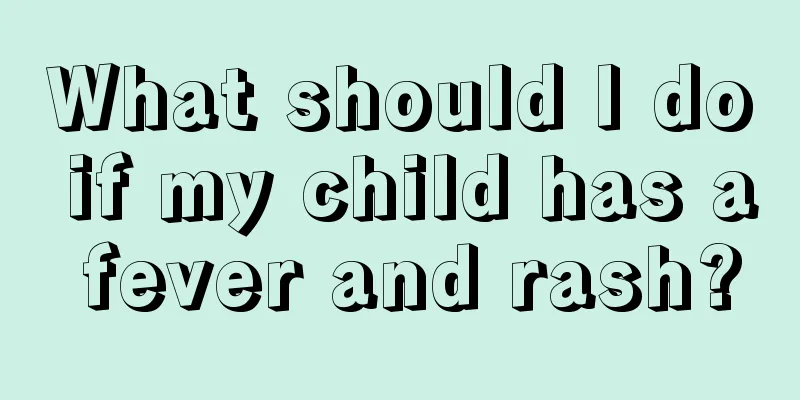The baby will have diarrhea after being vaccinated against leprosy

|
Leprosy is a common disease in our lives. Most of these diseases are contagious, so many children are vaccinated with leprosy vaccine right after they are born. However, there are many adverse reactions after vaccination. Some children may develop rashes within 24 hours, and some children may have a fever. So will babies have diarrhea after being vaccinated with leprosy vaccine? Based on clinical experience, the child's adverse reaction is probably not caused by the vaccine. Because vaccine reactions usually occur within 24 hours, and reactions can also occur 7-10 days after measles vaccination. The appearance of a rash on the buttocks after a child has a fever is not a reaction to the vaccine. Vaccine rashes should be systemic, and your child developed symptoms on the third day, so it is likely that he has a cold. If a child has a fever, cough, or sneeze, it should be a manifestation of respiratory infection and cold. If a child has a rash on his buttocks, it should be heat rash caused by the child's fever. It is recommended that you do not neglect the care of your child during routine medication, such as dressing and covering with a quilt appropriately to avoid aggravating the occurrence of heat rash after sweating. If your baby has no other symptoms and just has a fever, your baby may have a reaction to the vaccine. If he has a fever now and his temperature is 39 degrees, you can take oral antipyretic drugs, such as ibuprofen suspension, and make sure to drink plenty of water. At the same time, cooperate with physical cooling treatment. The method is to wipe the baby's skin all over the body with warm water at about 32℃ to 34℃. You can wipe for a little longer in areas with rich blood vessels, such as the armpits, groin, and armpits, to help dissipate heat. The chest, abdomen and other areas are sensitive to cold stimulation, so it is best not to wipe them. Leprosy invades the human body, and the incubation period is usually about 5 years, but there are also cases where it may take more than 20 years before the disease develops. The following are common symptoms of leprosy: 1. Tuberculoid leprosy Skin lesions include macules and plaques, usually one or two in number, with neat and clear edges, superficial sensory impairment, asymmetric distribution, and loss of vellus hair at the lesions, which is a very important feature. 2. Borderline tuberculoid leprosy This type occurs similarly to the tuberculoid type, with macules and plaques that are light red, purple red, or brownish yellow in color. Some patches have neat and clear borders, while some patches have "blank areas" or "hole areas" in the center, forming annular lesions with clear inner and outer edges. The skin within the hole area appears normal. 3. Intermediate borderline leprosy The rash types include macules, plaques, infiltrations, etc. The colors include wine red, withered yellow, brown, red, tan, etc. Sometimes two colors appear in one lesion. The lesions may be in the shape of bands, serpentines or irregular shapes. If they are in the shape of strips, one side will be clear and the other side will not be clearly infiltrated. 4. Borderline hematomatous leprosy This type of skin lesions include macules, papules, nodules, plaques and diffuse infiltration. Most of the lesions are tumor-like, with a large number, small shape, unclear boundaries, shiny surface, and red or orange color. The distribution is relatively wide and tends to be symmetrical. |
<<: How to give Yinzhihuang to babies
>>: What kind of pillow is good for a two-year-old baby?
Recommend
Heart failure in infants
Nowadays, many children may have to go through th...
Symptoms of fistula
The so-called rickets is mostly caused by calcium...
What should I do if my baby has a fever?
Many babies are the apple of their parents’ eyes....
What's wrong with a child who has convulsions while drinking milk?
Breastfeeding is the only way for babies to get f...
Why do children's joints make cracking sounds?
In life, many mothers often find that their child...
How to classify viral colds in children
It is common for children to catch colds and feve...
What food is good for children with diarrhea?
When the baby has diarrhea, not only the baby fee...
How to treat constipation in children?
Constipation in children is common in our lives. ...
What are the characteristics of pathological café-au-lait spots?
Café au lait spots are a type of common spots. Th...
Why do children have big bellies?
Many children have big bellies, which seriously t...
How to change baby diapers in winter
The weather is cold in winter. As a family with a...
What should teenagers do if they suffer from severe insomnia?
Many parents want their children to become succes...
What are the symptoms of knee synovitis in children?
Because children are relatively young, their body...
Reasons for hair loss in three-month-old babies
Many parents, when their baby is three months old...
Why do children have runny noses?
In fact, most children have runny noses, which ar...









